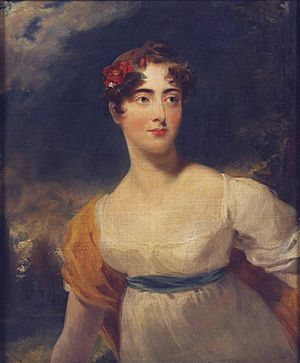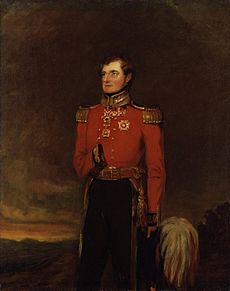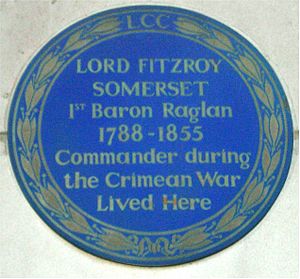FitzRoy Somerset, 1st Baron Raglan facts for kids
Quick facts for kids
The Lord Raglan
|
|
|---|---|
 |
|
| Birth name | FitzRoy James Henry Somerset |
| Born | 30 September 1788 Badminton, Gloucestershire, England |
| Died | 28 June 1855 (aged 66) Sevastopol, Crimea, Russian Empire |
| Buried | |
| Allegiance | |
| Service/ |
British Army |
| Years of service | 1804–1855 |
| Rank | Field marshal |
| Commands held | Master-General of the Ordnance British troops in the Crimea |
| Battles/wars | Napoleonic Wars Crimean War |
| Awards |
|
| Spouse(s) |
Lady Emily Wellesley-Pole
(m. 1814) |
Field Marshal FitzRoy James Henry Somerset, 1st Baron Raglan, was an important British Army officer. He was born on September 30, 1788, and passed away on June 28, 1855. Before 1852, he was known as Lord FitzRoy Somerset.
As a young officer, he served in the Peninsular War and the Waterloo campaign. He worked closely with the Duke of Wellington as his military secretary. Lord Raglan also took part in politics as a Tory Member of Parliament for Truro. Later, he became the Master-General of the Ordnance, a high military position.
In 1854, he became the commander of British troops sent to the Crimea. His main goal was to protect Constantinople. He was also ordered to besiege the Russian port of Sevastopol. After an early victory at the Battle of the Alma, a misunderstanding led to the famous Charge of the Light Brigade at the Battle of Balaclava. Despite another success at the Battle of Inkerman, a combined attack on Sevastopol in June 1855 failed. Lord Raglan became very ill and passed away later that month.
Contents
Early Life and Military Start
FitzRoy Somerset was born at Badminton House in Gloucestershire, England. He was the ninth and youngest son of the Henry Somerset, 5th Duke of Beaufort. His mother was Elizabeth Boscawen.
He went to Westminster School. In 1804, at age 15, he joined the army as a cornet in the 4th Light Dragoons.
Serving with Wellington
Somerset quickly rose through the ranks. In 1805, he became a lieutenant. He joined Sir Arthur Wellesley as his aide-de-camp in 1808. An aide-de-camp is like a personal assistant to a high-ranking officer.
Somerset went with Wellesley's army to Portugal. He fought in many important battles during the Peninsular War. These included the Second Battle of Porto in 1809 and the Battle of Talavera. He was wounded at the Battle of Bussaco in 1810.
In November 1810, he became Wellington's acting military secretary. He continued to fight alongside Wellington in battles like Battle of Pombal and Battle of Fuentes de Oñoro. He was promoted to brevet major in 1811.
Somerset showed great bravery at the storming of Badajoz in 1812. He was one of the first to enter the French fortress. For his courage, he was promoted to lieutenant colonel.
He continued to serve with Wellington in major battles. These included the Battle of Salamanca in 1812 and the Battle of Vitoria in 1813. He also fought in the Battle of the Pyrenees and the Battle of Toulouse.
After the Peninsular War, Somerset worked as Wellington's secretary in Paris. He was made a Knight Commander of the Order of the Bath in 1815.
Waterloo and Later Career
Somerset also fought in the Hundred Days campaign. He was with Wellington's staff at the Battle of Quatre Bras and the Battle of Waterloo in 1815. At Waterloo, he was seriously wounded and had his right arm amputated. He famously asked for his arm back to retrieve a ring his wife had given him.
After Waterloo, he was promoted to colonel. He became an aide-de-camp to the Prince Regent. He also received an award from Bavaria. He stayed with the army in France for a while before returning to Paris as a secretary.
In 1818, Somerset was elected as a Tory Member of Parliament for Truro. He became Wellington's secretary again when Wellington was Master-General of the Ordnance.
He lost his Parliament seat in 1820 but got it back in 1826. He was promoted to major-general in 1825. When Wellington became Commander-in-Chief of the Forces in 1827, Somerset became his Military Secretary.
He left Parliament in 1829. He was promoted to lieutenant-general in 1838. In 1852, he received a higher honor, becoming a Knight Grand Cross of the Order of the Bath. He then became Master-General of the Ordnance. On October 11, 1852, he was given the title Baron Raglan.
The Crimean War
In February 1854, Lord Raglan became the commander of the British troops sent to the Crimea. He was given the temporary rank of full general. His main job was to protect Constantinople. He was also ordered to besiege the Russian port of Sevastopol.
A combined British and French force, led by Raglan and General Jacques St. Arnaud, defeated the Russian army. This happened at the Battle of the Alma in September 1854.
During the war, Raglan sometimes mistakenly called the Russian enemies "the French." Even though he spoke French well, this habit was seen by some as a sign he wasn't fit for command. However, relations between the British and French armies were generally good.
At the Battle of Balaclava in October 1854, Raglan gave an order to his cavalry commander. This order led to the famous Charge of the Light Brigade. About 278 British soldiers were killed or wounded in this charge.
Despite the difficult outcome at Balaclava, the British and French armies won another victory. This was at the Battle of Inkerman in November 1854. Raglan was promoted to field marshal on November 5, 1854. He also received an award from the Ottoman Empire.
Raglan faced criticism from the press and government. They blamed him for the terrible conditions British soldiers faced during the Crimean winter. There were shortages of food and clothing during the Siege of Sevastopol. However, part of the problem was that the authorities back home failed to send enough supplies.
A combined attack on Sevastopol on June 18, 1855, failed completely. The stress of the siege affected Raglan's health. He became very ill and passed away on June 28, 1855. His body was brought back to England and buried at St Michael and All Angels Church, Badminton.
A special house called Cefntilla Court was built in 1858 to remember Lord Raglan. A plaque was also placed outside his house in London in 1911.
Family Life

On August 6, 1814, FitzRoy Somerset married Lady Emily Harriet Wellesley-Pole. She was the daughter of William Wellesley-Pole, 3rd Earl of Mornington. She was also the niece of the Duke of Wellington.
They had five children:
- Charlotte Caroline Elizabeth Somerset (born 1815)
- Arthur William FitzRoy Somerset (born 1816)
- Richard Henry Fitzroy Somerset, 2nd Baron Raglan (born 1817)
- Frederick John Fitzroy Somerset (born 1821)
- Katherine Anne Emily Cecilia Somerset (born 1824)
In Popular Culture
Lord Raglan has been shown in movies and books.
- He was played by John Gielgud in the 1968 film The Charge of the Light Brigade.
- He is a character in George MacDonald Fraser's novel Flashman at the Charge. In the book, he is described as a kind but not very effective leader.
See also
 In Spanish: FitzRoy Somerset para niños
In Spanish: FitzRoy Somerset para niños
- Raglan sleeve




